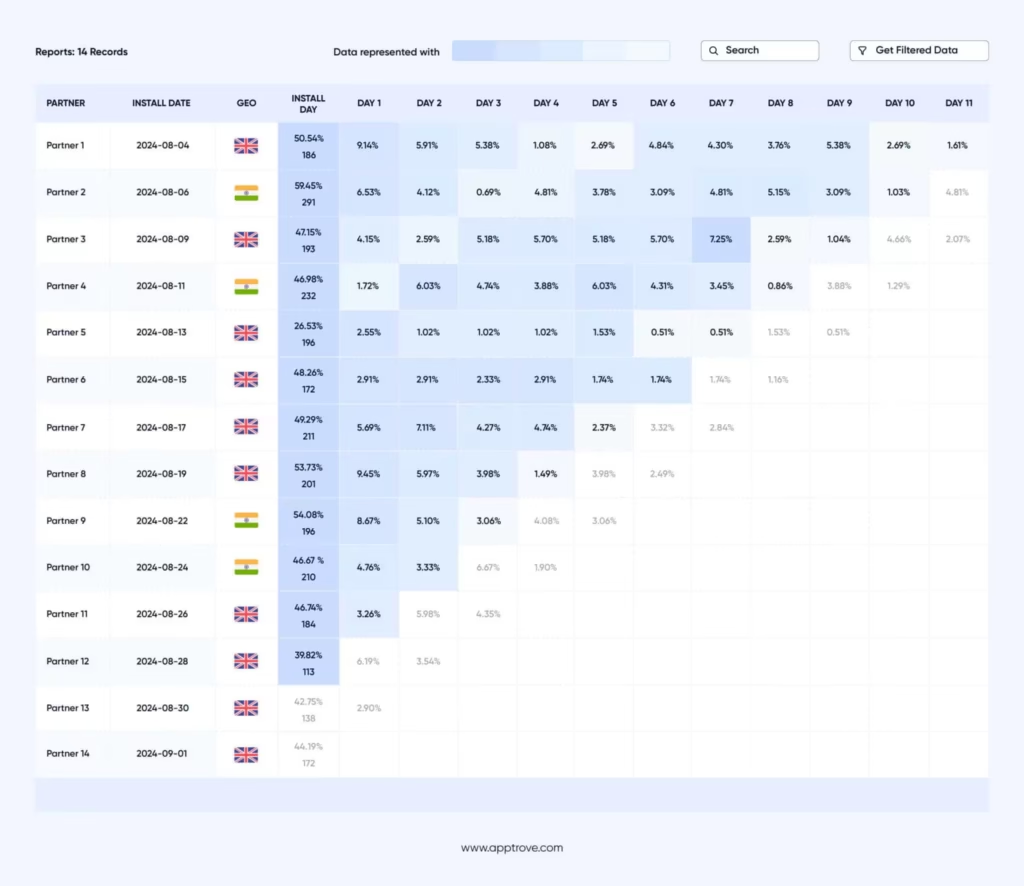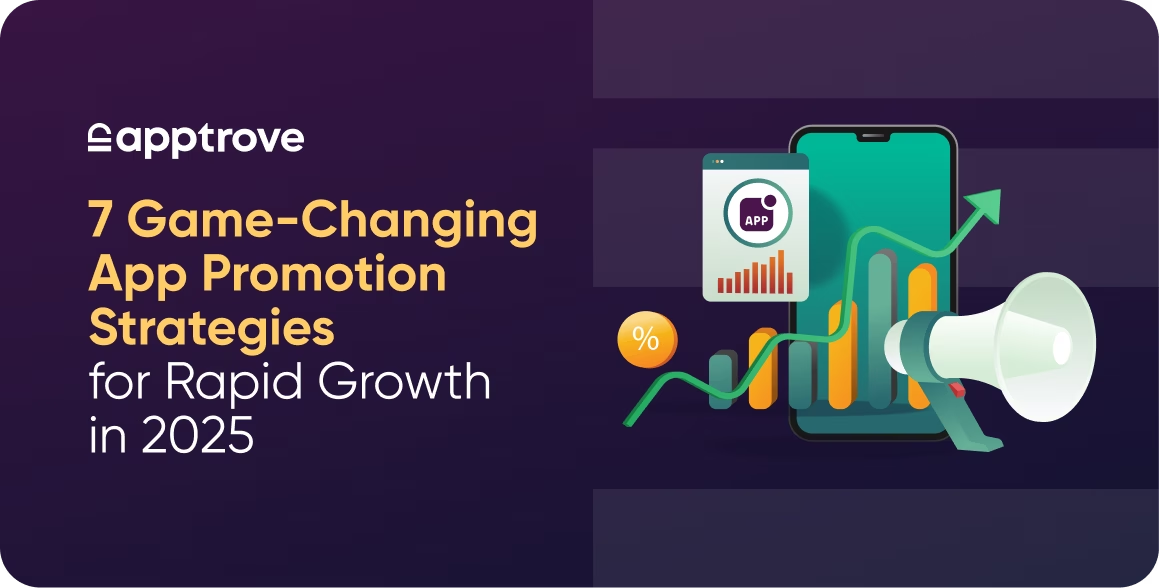The mobile ad spending share in the total spend on digital advertising is expected to reach 68% by 2027.
For mobile app marketers, marketing attribution is essential in understanding the most essential factors driving the performance of their mobile app. A proven way to reduce the attribution process’s complexity is to strategically create and base analysis on cohorts.
Let us start by understanding cohort analysis meaning, its benefits, and the best practices mobile app marketers should follow.
What Is Cohort Analysis in Mobile Marketing?
Cohorts refer to groups of users that have been classified based on common identifiers, such as preferences, demographics, or more. Since having a commonality is the crucial factor, cohorts can be based on a simple factor such as a common geographical location, or a bit complex such as recorded interest in a product.
The process of segmenting users into cohorts for a specific period to measure KPIs is known as cohort analysis. When done properly, advanced cohort analysis can produce mobile app analytics that can shed light on which campaigns work best for the brand, and how specific audiences are receiving them.
Why Should Mobile Marketers Care About Cohort Analysis?
As a mobile marketer, you will be dealing with app cohort analysis at some point. Let’s start by understanding cohort analysis types to be aware of when you conduct cohort analysis.
Types of Cohort Analysis
- Demographic Cohort Analysis: This type of customer cohort analysis is based on demographic factors such as location, age, gender, etc. Primarily, mobile apps use this type of cohort to group users based on geographical locations.
- Behavioral Cohort Analysis: This customer cohort analysis is carried out on a group of users that share the same behavioral patterns or actions. Creating a cohort of users that have subscribed to an email list for subscription cohort analysis is a good example.
- Acquisition Cohort Analysis: This analysis groups users based on specific acquisition events such as recent onboarding, first sign-up, or recent transition to a premium plan. These are conversion-based cohorts that can give you insights into what parts of your app or product are working.
Benefits of Cohort Analysis
Let us now look at the benefits of cohort analysis in mobile marketing attribution. The primary merit of cohorts is that it can help you compare and analyze data more easily and apply key performance metrics on specific user groups.
Here are a few other benefits.
- Prevent and Combat Ad Fraud
Mobile ad fraud can drain your marketing budget, wasting a lot of your time and resources. With cohort analysis in marketing, you can identify micro-patterns in specific user groups, making it easier to spot indications of fraud and eliminate them.
With the help of Apptrove, you can then set up anti-fraud shields that prevent further fraud and detect any future instances. - Test Out New Features
Cohorts can especially be useful when you want to test out specific changes made in your mobile app.
For instance, if you have introduced new changes to your user onboarding process, creating a cohort of users who have installed your app recently and testing the changes on this segment will be useful.
- Strengthen Your Re-Engagement Campaign
To get the most out of your re-engagement campaigns, you should be able to get the seasonality and timing right. Cohort analysis can help you pinpoint specific periods of highs and lows in campaigns that you can then narrow down on, to maximize performance.
- Track Key Performance Metrics More Effectively
By dividing users into cohorts, mobile app marketers can calculate key performance metrics more easily. You can analyze and optimize various metrics such as Lifetime Value (LTV), Retention Rate, and other engagement metrics and tailor remedial actions to specific cohorts to maximize your ROI.
2 Practical Cohort Analysis Examples
Let us look at a couple of practical examples for understanding cohort analysis and its applications better.
#1 Measuring The Effectiveness of the Changes in the User Onboarding Process
As a mobile app marketer, you want to showcase the best features of your app to your users. But there may be some parts of your mobile app that may be visible or relevant only for certain users. The new user onboarding process in your app is one such part.
So, if you make improvements or changes to the flow of this part of your app, how will you test it out?
With the help of marketing cohort analysis, you can make cohorts consisting of users who have recently signed up for your app or recently moved from a free version to the premium version of your app. This is the ideal cohort to tell you more about their experience with those changes in the onboarding process.
You can circulate surveys to this specific cohort while they are using the app or through emails. Based on the feedback, you can gauge whether the changes made to the onboarding process have been successful or you need to tweak anything.
#2 Analyzing the Performance of a Multi-Regional Remarketing Campaign
Say, you are marketing a gaming app that lets users purchase character skins and other items that can be used in the game. Technically, the game is free to play and free of ads, but these in-app purchases and season passes are how you generate revenue.
In this case, you might want to invest in remarketing campaigns to encourage existing users in specific regions to make in-app purchases. If you run regular remarketing campaigns, you may want to know about the regions in which your marketing campaigns succeeded the most and run another iteration of the same campaign.
Cohort marketing analysis will help you remarket the products or items in your store to a cohort that is highly likely to complete a purchase. You may already be tracking metrics such as purchase revenue or in-app purchases, but with the help of cohort analysis, you can track more metrics and narrow down user behavior and related KPIs more comprehensively.
As a result, you will have a better idea of the cohorts your remarketing campaigns are most effective on.
Tired of guessing how your marketing campaigns are performing? Our free guide reveals the secrets of cohort analysis, empowering you to track user behavior, measure retention, and optimize your strategy.
6 Best Practices for Cohort Analysis Success
Now that we have covered the basics of what is cohort analysis, let’s look at some of the best practices that follow.
#1 Define Objectives and Cohorts Clearly
Ensure that you have a list of clearly defined objectives that you want to achieve. For instance, your objectives may include boosting user retention or measuring the effectiveness of new features on user engagement.
Defining objectives will ensure that you choose the right metrics to guide your cohort analysis. Once you have a defined list of objectives, you need to come up with meaningful criteria to define your cohorts.
Depending on your goals, these criteria can vary from the first purchase date or even a geographical region. The more accurate your cohort identification, the more meaningful your insights will be.
#2 Ensure Quality and Consistency in Data
When you want to conduct a reliable analysis, you must ensure that the data you are using is high-quality and consistent. To ensure that your data is of the best quality, clean it by removing duplicates and correcting errors.
Data accuracy also includes implementing policies that standardize the data collected from various sources.
An MMP like Apptrove guarantees the accuracy and credibility of the data and related analytics.
#3 Choose the Right Metrics
Once you have a set of clearly defined objectives and a high-quality dataset, your choice of metrics is the key to unlocking valuable insights into the user base, mobile advertising, and marketing efforts.
The metrics you select should be aligned with the objectives. For instance, when you want to measure and improve your user engagement, metrics such as session frequency and session duration will help.
#4 Leverage Data Visualization
When you are looking to conduct a comprehensive cohort analysis, you will undoubtedly be dealing with multiple cohorts and a large volume of data. Analyzing all of this data can get quite complicated and lead to errors if smart ways are not leveraged to visualize it.
Leverage visualization methods such as line charts, heatmaps, and bar charts to represent large volumes of data in your cohort analysis. Doing so can simplify the process of identifying any trends and patterns in data and making decisions based on them.
#5 Consider Further Segmentation
When dealing with volumes of data associated with large user groups, your cohort analysis will be more layered. That’s where segmentation helps.
Say, you define a cohort analysis based on the signup date of users including the ones that have signed up in the past month to measure their engagement rate. Once you have collected the necessary insights, you can segment the cohort further in terms of location or demographic for a detailed analysis.
#6 Take External Factors into Account
When you conduct cohort analysis, it is necessary to be aware that external factors can impact the quality of your results. It is recommended that you keep an eye on seasonal trends and market conditions that force a change in the behavior and performance of the cohorts.

Cohort Analysis with Apptrove
The effectiveness of the decisions you make based on the data derived from your cohorts will determine whether your cohort analysis was successful.
With Apptrove, you can ensure that you add an extra layer of detailing and accuracy to your cohort analysis dashboard with the following features:
- Granular Audience Segmentation
Apptrove’s granular filters ensure that you always have well-defined cohorts based on user behavior, purchase intent, or any other custom filters that will help you create contextual experiences for users to boost their lifetime value.
What’s more, can also segment users into custom cohorts as per the conditions you determine, all while ensuring data privacy. As a result, you will get deeper insights into user behavior by tracking relevant KPIs. - Anti-Fraud Mechanisms
With Apptrove, you can utilize 7-layered fraud settings to ensure data security for each campaign, network, and channel you work with. With your marketing campaigns and efforts fully guarded with anti-fraud shields, you can derive decisive insights into your app growth and create impactful cohorts. - Adherence to Privacy Regulations
Equipped with all the major certifications such as GDPR, CCPA, ISO 27001, and ePrivacy, Apptrove ensures complete adherence to privacy regulations. To ensure your data privacy, Apptrove also implements AES256 encryption on all the data that is in storage or transit.
Apart from this, you get access to the multi-layered defense mechanism that is in place including API shields, anti-DDoS protection, WAF, and more. - Superior Customer Support
With an MMP like Apptrove on your side, you will never have to wait for query resolution. Right from personalized onboarding to timely ticket management, Apptrove provides unparalleled 24/7 customer support.
What’s more, you shall always have a team consisting of dedicated customer success managers, account managers, and tech specialists on standby to address your concerns.
Summing Up
Cohort analysis is a crucial part of the mobile marketing and attribution process, and as a mobile app marketer, you will inevitably be tasked with creating cohorts at some point. Ensure that you follow some of the best practices mentioned in this article when you are conducting cohort analysis so that you can unlock powerful insights into your app performance.
Apptrove is a mobile measurement platform that mobile app owners can leverage to automate and empower their marketing attribution process. With data-driven insights, anti-fraud shields, and privacy certifications to ensure mobile app data security and compliance, you can map out more effective and seamless customer journeys.
Contact our team to get started and gain powerful insights into your cohorts.
FAQs
1. What is cohort analysis meaning in mobile marketing?
Cohort analysis in mobile marketing refers to organizing users based on common characteristics that occurred at a point in time. This could be the date they sign up, making their first in-app purchase, or perhaps their first exploratory action in your app. Cohort analysis is useful for tracking retention, engagement, and return on investment (ROI).
2. How do app marketers use cohort analysis?
As mentioned above, cohort analysis is tracking how a user behaves over time. It can track user retention patterns, reduce churn, and optimize mobile campaigns for actionable conversions.
3. What are the types of cohort analysis?
The three main types of cohort analysis are acquisition cohorts (which are based on the date a user signed up or installed the app), behavioral cohorts (which are based on an in-app action taken by the user), and demographic cohorts (which are based on vast attributes of the users such as age, geographical location, etc., that have been captured initially or at a later stage).
4. Why is cohort analysis important for growth?
Cohorts are imperative to your app growth because cohort analysis will provide insight into which users provide the most value to your app. It will also highlight the area where churn happens and improve the strategy of how you would want to retarget with the aim of improving users lifetime value.
5. How does Apptrove support cohort analysis?
Apptrove enables smarter cohort analysis through enhanced segmentation, fraud detection, real-time reporting, and adherence to user data privacy regulations, helping app marketers drive superior retention and revenue.






